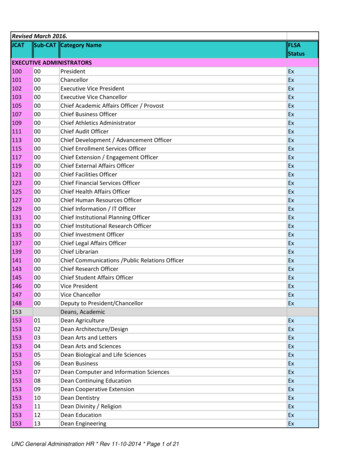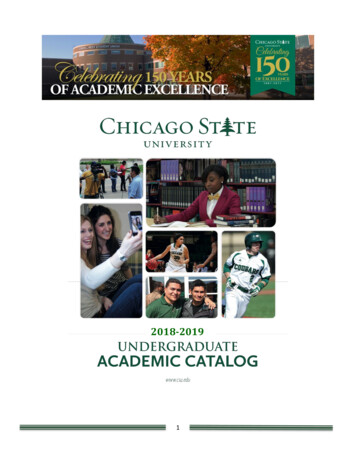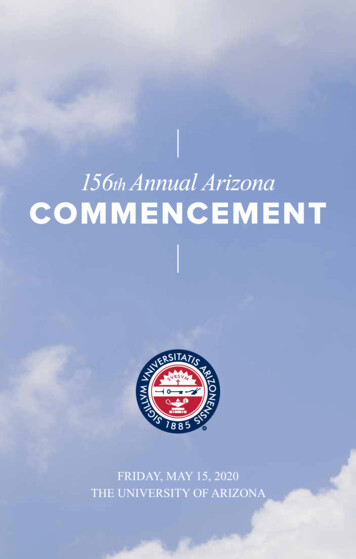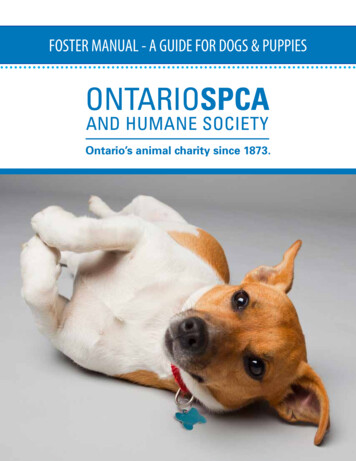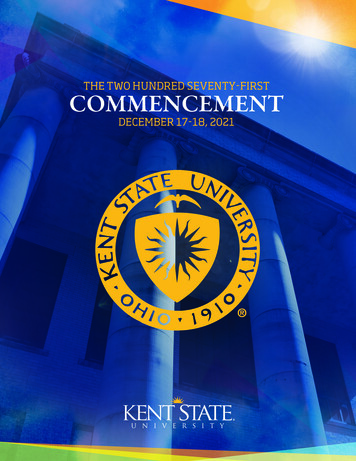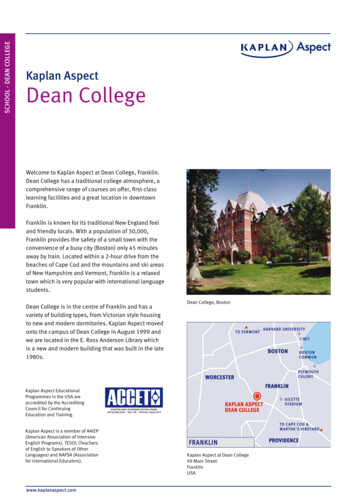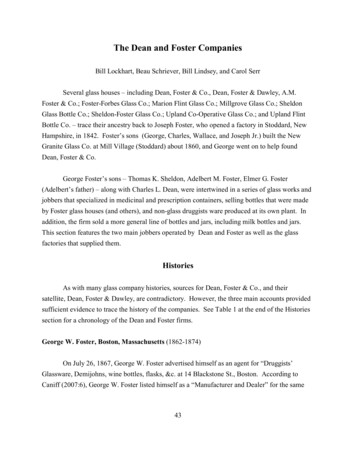
Transcription
The Dean and Foster CompaniesBill Lockhart, Beau Schriever, Bill Lindsey, and Carol SerrSeveral glass houses – including Dean, Foster & Co., Dean, Foster & Dawley, A.M.Foster & Co.; Foster-Forbes Glass Co.; Marion Flint Glass Co.; Millgrove Glass Co.; SheldonGlass Bottle Co.; Sheldon-Foster Glass Co.; Upland Co-Operative Glass Co.; and Upland FlintBottle Co. – trace their ancestry back to Joseph Foster, who opened a factory in Stoddard, NewHampshire, in 1842. Foster’s sons (George, Charles, Wallace, and Joseph Jr.) built the NewGranite Glass Co. at Mill Village (Stoddard) about 1860, and George went on to help foundDean, Foster & Co.George Foster’s sons – Thomas K. Sheldon, Adelbert M. Foster, Elmer G. Foster(Adelbert’s father) – along with Charles L. Dean, were intertwined in a series of glass works andjobbers that specialized in medicinal and prescription containers, selling bottles that were madeby Foster glass houses (and others), and non-glass druggists ware produced at its own plant. Inaddition, the firm sold a more general line of bottles and jars, including milk bottles and jars.This section features the two main jobbers operated by Dean and Foster as well as the glassfactories that supplied them.HistoriesAs with many glass company histories, sources for Dean, Foster & Co., and theirsatellite, Dean, Foster & Dawley, are contradictory. However, the three main accounts providedsufficient evidence to trace the history of the companies. See Table 1 at the end of the Historiessection for a chronology of the Dean and Foster firms.George W. Foster, Boston, Massachusetts (1862-1874)On July 26, 1867, George W. Foster advertised himself as an agent for “Druggists’Glassware, Demijohns, wine bottles, flasks, &c. at 14 Blackstone St., Boston. According toCaniff (2007:6), George W. Foster listed himself as a “Manufacturer and Dealer” for the same43
products in October 1869. The listing noted that the firm was “established 1862.”1 Thecompany almost certainly was the ancestor to Dean, Foster & Co. This was the same GeorgeFoster who – with his brothers – opened the New Granite Glass Works at Stoddard, NewHampshire, ca. 1860. He may have created the jobber firm to vend the glassware produced atNew Granite. When Foster and his brothers sold the firm to Charles B. Barrett in late 1867, thejobber firm probably began to sell products from other glass houses. This would certainly havebeen true after the Stoddard plant burned in 1871. See the section of the Granite Glass Co. formore information.The connection between Foster’s firm and A.E. Buck & Co. has not been explored. Bothfirms claimed the 14 Blackstone St. address at Boston during the 1870s. Foster’s future partner,John S. Dean was one of the major shareholders – along with Edwin A. Buck – in the WestfordGlass Co., Westford, Connecticut, when the company incorporated on March 21, 1857. Whenthe glass house went bankrupt on May 18, 1865, Buck (with Dean) reorganized the company asA.E. Buck & Co. – a glass jobber – later that year. Arthur J. Dawley and Albert G. Smalley alsoworked for Buck.Although the sources are unclear, the Westford Glass Co. also seems to have reorganized– retaining its old name – and was operated by E.A. Buck & Co. The glass house probablyserved both Buck and the Dean, Foster combine (McKearn & McKearin 1941:609; McKearin &Wilson 1978:151-152; Wilson 1972:151-157). The sharing of the address obviously placedDean and Foster in close contact with each other, and set the scene for the next reorganization.A.E. Buck & Co. remained in business until at least 1906. For more information about theWestford Glass Co., see the Other W section in the W Volume.Dean, Foster & Co., Boston, Massachusetts (1874-ca. 1911)Sources disagree as to the founding date of Dean, Foster & Co. O’Leary and Czaplewski([1898] 2002) suggested that company was actually established in 1877, but another early source(Ashford, Connecticut Biographies [1889] 2004) placed 1874 as the founding date. The official1The 1862 date was also claimed as the founding year in the Adelbert M. Foster 1907catalog.44
company history (Foster-Forbes [ca. 1966]) set the inception date at 1871, and Caniff (2007:6)claimed that the partnership began in 1872. The 1874 Boston city directory listed A.E. Buck &Co. but did not include Dean, Foster & Co. Dean, Foster & Co. first appeared in the following(1875) edition. Leonard (1905:244) noted that Adelbert M. Foster entered Dean, Foster and Co.on October 14, 1874, so the business was certainly in operation by that date. We thus accept late1874 as the most likely date that George Foster, Charles L. Dean, and Albert G. Smalley formedthe original firm of Dean, Foster & Co., glassware jobbers (wholesalers), at Boston,Massachusetts.Foster’s other son, Elmer G., entered the business the following year and was listed asreplacing George as president. Smalley vanished from the records at some point after 1875.Arthur J. Dawley joined the firm in 1876. Under the name of Dean, Foster & Dawley, he openedthe branch at Chicago in 1883 (Bethman 1971:75; Connecticut Genealogy 2004-2005; FosterForbes [ca. 1966]; O’Leary & Czaplewski [1898] 2002). The branch reverted to the Dean,Foster & Co. name, when Dawley withdrew in 1889.Although the firm had offices in Boston and Chicago, most of the bottles were made inConnecticut during the 1870s. In announcing the winning of a bronze medal in the “glass”category in 1878, the judges noted that the exhibit had “good quality and form, and neatly gildedand decorated labels, its bottles for druggists’ use deserve special commendation” The 1878source also stated that “the manufactory for [Dean, Foster & Co. is] in Westford, Connecticut”and noted that some of its products came from the “well-known Dorflinger Glass Company, ofWhite Mills, Penn.” (Charitable Mechanic Association 1878:76).Dean, Foster & Co. was a wholesale house for druggists’ ware and ceramic jugs. Thejugs, as well as the early pharmacy bottles and associated glass implements, were made by theWestford Glass Co. After Westford closed (possibly ca. 1878), the stoneware jug business atDean Foster seems to have ceased. C. Dorflinger & Co. certainly made some of the fancy “shopfurniture” for Dean, Foster & Co. In fact, Dorflinger may have built an entire factory to supplythe products. The Wayne Citizen noted in May 1875 that “Mr. Dorflinger is erecting for someNew York parties upon his property at White mills, a building . . . for the manufacture ofdecorative glass ware, such as druggist labels, etc.” (Barbe & Reed 2003:142). This was almostcertainly the company noted in 1878.45
A Dorflinger subsidiary, the Honesdale Glass Co., may have supplied more mundanedruggists’ bottles at some point. Opened by at least 1873, the plant made green and ambercontainers, including druggists’ bottles (see descriptions of both companies below). The MarionFlint Glass Co., Marion, Indiana, with A.M. Foster as secretary, almost certainly picked up mostof the business when it opened in 1888 and probably continued supplying Dean, Foster & Co.(Barbe & Reed 2003:44-47, 143). A Dean, Foster & Co. letterhead from 1892 included adrawing of the “Marion Factory” – an obvious reference to the Marion Flint Glass Co. as thefirm’s supplier (Tyson 1971:13).In 1884, a billhead for Dean, Foster & Co. claimed the firm was “Manufacturers ofDruggists’ Green And Flint Glass Ware, Rubber Goods And Sundries, Demijohns, Bottles AndFlasks, Lager Beer Bottles And Lightning Stoppers. Factory At Philadelphia” (quoted in Roller1998a). The Philadelphia factory may have been the Storm Brothers, who made druggists’bottles at the West Philadelphia Glass Works (Roller 1998b). We have discovered no otherPhiladelphia factory from that time period that was making druggists’ goods.By at least 1892, Dean, Foster & Co. offered milk bottles. The firm wrote to CharlesYockel, a Philadelphia mold maker, ordering a quart “milk jar” with the request that the moldsbe sent to J.T. & A. Hamilton in Pittsburgh (Tyson 1971:13). Hamilton was a noted milk bottlemanufacturer at the time and probably became the regular supplier for milk bottles for Dean,Foster customers.The company also sold Mason jars. On March 9, 1893, the Pottery & GlasswareReporter reported:Not many firms can refuse to sell goods except in car load lots alone. This,however, is the case with the fruit jars from the factories of Dean, Foster & Co.,Glass Manufacturers, 120 Lake Street, Chicago. Their immense factory is atMarion, Ind., and turns out a line of jars that can always be depended upon(quoted in Roller n.d.)The jars described were labeled “MASON / PATENT / NOV. 30TH 1880.”46
Bethman (1971:75) noted that the company was in business “past the turn of thecentury,” and Caniff (2007:6) stated that the 1909 catalog was the last known mention of thecompany. The Thomas Registers (Thomas Publishing Co. 1905:103; 1907:158; 1909:200) listedthe firm until 1909, although there was a gap in publication between 1909 and 1912. The firmmost likely closed ca. 1911, when Foster bought the Upland Flint Bottle Co.Table 1 – Chronology of Foster-Family Related Glass OperationsCompanyDates in BusinessType of BusinessSouth Stoddard Glass Works1850-1873FactoryNew Granite Glass Works1860-1871FactoryDean, Foster & Co.1874-1911JobberDean, Foster & Dawley1883-1893JobberMarion Flint Glass Co.1887-1922FactoryA.M. Foster & Co.1893-1928JobberSheldon-Foster Glass Co.1894-1911FactoryMillgrove Glass Co.1903-1911*FactoryUpland Flint Bottle Co.1911-1929FactoryFoster-Forbes Glass Co.1929-1971Factory* C.H. Modes incorporated the company in 1898, but A.M. Foster did not acquire control until1903.Dean, Foster & Dawley, Chicago, Illinois (1883-1889)In 1883, Arthur J. Dawley opened a branch of Dean, Foster & Co. in Chicago under thename of Dean, Foster & Dawley, “occupying the whole of a five-story building at 120 LakeStreet in Chicago, and the other two partners being in Boston” (O’Leary & Czaplewski [1898]2002). When Adelbert M. Foster entered the firm, he was either in Chicago or soon movedthere. On April 14, 1885, the building was damaged by fire but not destroyed. Because of poorhealth, Dawley severed his connection to the company on April 1, 1889. It is likely that A.M.47
Foster continued to operate under the Dean, Foster & Dawley name until he purchased theChicago business October 9, 1893, and renamed it A.M. Foster & Co. (Bethman 1971:75;O’Leary & Czaplewski [1898] 2002; von Mechow 2014). See the section on A.M. Foster formore information on that firm. The company still made bottles and glass jars in 1928, therewere no more listings after that time (Bethman 1971:73).Containers and MarksD.F.&D. (1888-1893)According to Bethman (1991:74), Dean, Foster, and Dawleyproduced and distributed “many styles of prescription bottles, but oneparticular style of prescription bottle, the Chicago Oval, has the basemarkings of D.F.&D. The bottle design was patented on May 15, 1888,and was a very popular early prescription bottle. They continued to offerthe Chicago Oval for sale until about 1900.” Bethman obviouslyincluded Dean, Foster & Co. as “they” because Dean, Foster & Dawleyclosed by at least 1893. The design was actually patented by AdelbertM. Foster, Design Patent No. 18,309. The bottle continued to be listedin the A.M. Foster 1907 catalog (Figure 1).Bethman(1991) illustratednumerous bottlesembossed withD.F.&D (Figure 2).All bottles were theFigure 2 – D.F.&D. on Chicago Oval (Bethman1991:762)Figure 1 – ChicagoOval (A.M. Foster1907 catalog)same style, and allwere identically embossed with “M / PAT’DMAY 15 88 / D.F.&D.” The same style bottle was identically marked except for the substitutionof D.F.&CO. (e.g., Bethman 1971:397). All D.F.&D. bottles shown in Bethman were datedbetween 1888 and 1890. Examples from eBay, however, show bottles without the “M” and onemarked “D.F.&D. (in a very slight arch) / PAT’D MAY 15 88 / F” (Figure 3). In all cases we48
have seen, the mark is read with the oval side of the bottle up. Examples in Burgraaf andSouthard (1998:511, 545), Clint (1976:118), Feldhaus (1986:9, 10, 29), Griffenhagen and Bogard(1999:123), Kroll (1972:62, 135, 140, 142), and Preble (2002:475, 696) all fall within or close tothe date range set by Bethman.The accompanying letters likely represent the manufacturingglass houses. The “M” is an obvious indicator of the Marion FlintGlass Co., a Foster affiliate. The “F” probably indicates the SheldonFoster Glass Co. as suggested by Griffenhagen and Bogard (1999:41).If so, the bottles were made after A.M. Foster took charge of theChicago firm; Sheldon-Foster did not open until 1894. A mold andbaseplate may have been shipped to Sheldon-Foster and the “M”Figure 3 – D.F.&D. Mvariation (eBay)altered to an “F.” It would be interesting to observe an actual example of the “F” mark to see ifan alteration is noticeable. This all suggests that the bottles with the “M” bases were the onlyones made prior to 1894, but bottles with both letters could have been made after that time.The D.F.&D. logo also appeared on beer and/or soda bottles. Mobley (2014) featured asingle champagne beer bottle with an applied blob finish with the logo on the base. Hutchbook(Fowler 2014) included a single example of a Hutchinson soda or beer bottle embossed“D.F.&D. / 21” on the base.D.F.&Co. --no rays (1890-at least 1901)Toulouse (1971:160) noted the “DF&Co / M” mark but listed it as “maker unknown” anddated it “circa 1890 to 1900[;] technique.” In most cases, however, the “M” was embossedabove both the mark and the patent date. As noted above, the “M” likely represented the factoryat Marion, Indiana.Bethman (1991) illustrated numerous bottles embossed with D.F.&CO. without the“rays” (see “ray” discussion below). All bottles were the same style, and all were identicallyembossed with “M / PAT’D MAY 15 88 / D.F.&CO.” These were the same Chicago oval thatwas also marked “D.F.&D.” (see D.F.&D. above). All D.F.&CO. bottles (without “rays”) shownin Bethman were dated between 1889 and 1893.49
Elliott and Gould (1988:199) listed a single milk-glass ointment jar embossed on the baseDF&CO1898. The jar was used ca. 1898 by the Hollister Drug Co., Honolulu, Hawaii. This isthe only example we have seen embossed with a date, although the year could refer to a patent,or it could be a model or catalog code. On cylindrical bottles, the DF&CO mark may have beenused until the end of the company. Ring (1980:86) listed a “DF&Co / 14” mark on the base of aBlahnik’s Celebrated Stomach Bitters bottle. Unfortunately, she provided no dates or otherinformation. The bottle was square, however, and was unlikely to have had the “rays.”The 1901 Dean, Foster & Co.catalog (Freeman 1964:X8 [plate])illustrated the Chicago Oval, embossed “M /PAT MAY 1888 / D.F.&CO.” (althoughsome of the letters in the catalog arecovered by the number “22” pasted on thebase – also see Figure 1). The Chicago OvalFigure 4 – D.F.&CO. on Chicago Oval (Miller2008:225)was available in 1901 in ½- to 32 ouncesizes plus 3- and 4-ounce wide mouth styles. The “no rays” variant is only found on ChicagoOvals. Miller (2008:210, 225), showed a total of four drug store bottles embossed “M / PATMAY 1888 / D.F.&CO.” (Figure 4). He dated the bottles within a range of 1890-1893 based onlocal company information.Although the use of the full company name was more common (see below), the firm soldat least one Huitchinson bottle embossed “D.F.&CO” on the base (Fowler 2014). Neither sodanor beer bottles appeared in the 1901 Dean, Foster & Co. catalog or the one from A.M. Foster &Co. in 1907.D.F.&Co. – with rays (1894-1911)This mark – D.F.&CO. with “rays” or a sunburst design – was used by Dean, Foster &Co., probably from the inception of the Sheldon-Foster factory to the end of Dean, Foster – 1894to 1911. The rays could vary in number and shape (from at least 20-27), probably depending onthe size of the bottle and the individual mold maker (Figure 5). Bethman (1991) illustratednumerous examples of the mark with “rays” and dated those between 1890 and 1898. Bethman50
alsoillustratedthe samebottleembossedFigure 5 – D.F.&CO. with rayson thebase witha “2” or “3” surrounded by rays (Figure 6).These were almostcertainly also madefor Dean, Foster.Figure 6 – D.F.&CO. or numbers with rays(Bethman 1991:817)Miller (2008:210, 225), Pollard (1993:233-234) and Preble (2002:419,651-652) also illustrated the mark, with date ranges within the 18801900 period. Griffenhagen and Bogard (1999:123) dated the mark 1888to 1900, probably echoing Bethman.The 1901 Dean, Foster & Co. catalog (Freeman 1964:X8 [plate])showed a base with “rays,” but the catalog makers photographed bottlesfor the catalog with numbers applied to the center of the bases. Onbottle #20, the number covered up all initials, only exposing the rays.The general outline of the base and form of the bottle are identical withthose illustrated by Miller and others. The style was called an EastlakeOval, and it was offered in ½- to 32-ounce sizes (Figure 7).Griffenhagen and Bogard (1999:42) also noted that the initials withFigure 7 – EastlakeOval (A.M. Foster1907 catalog)“lines radiating outward around them” were found on Eastlake Ovals,probably using information from the catalog.DFCO (after 1900?)Preble (2002:596) illustrated this mark on a single drug store bottle. It is almost certainlya typographical error for DF&CO or an engraver’s error. However, at least one blob-top sodabottle offered on eBay was embossed on the base with “D.F.Co. (arch) / E (large) / BOSTON(inverted arch).” See next entry for a discussion of date range.51
DEAN FOSTER CO. (1900-1901)Miller (1999:238) showed this mark embossed on the base of anunusual oval bottle with a non-traditional finish (Figure 8). Althoughmarked with a circular plate mold from a Tucson, Arizona, drug store, thislooks more like a toiletry bottle than a typical pharmacy bottle. Millerdated the bottle 1900-1902. It is possible that bottles made in 1900 andlater used this mark; however, this could also be a mark used only onspecialty bottles made for Dean, Foster. A final possibility is that thecompany dropped the ampersand (&) in 1900 and used either the name orinitials. The bottle did not appear in either the 1901 Dean, Foster or 1907A.M. Foster catalogs.Figure 8 – DEANFOSTER CO. (Miller1999:238)DEAN FOSTER & CO. (1874-early 1890s)Lincoln (1970:86) illustratedcylindrical blob-top bottles marked on thebase with “DEAN FOSTER & CO.(downward arch) / MADE BY (horizontal) /BOSTON (upward arch) and noted sixexamples of the mark on New EnglandFigure 9 – DEANFOSTER & CO. base(eBay)bottles (Figure 9). Unfortunately, Lincolnmade no attempt to date any of the bottles hepresented, so the mark must be dated for theentire tenure of the company (1890-1911). Kroll (1972:108, 133) alsolisted two Wisconsin beer bottles marked Dean, Foster & Co. The twobreweries operated from 1884 to the 1890s. Kroll (1972:3) noted that“most bottles marked with Dean, Foster & Co. are very early(1870’s–1890’s).” Pollard (1993:50, 99, 132) also illustrated bottleswith the mark. An eBay example of the bottle with the mark showed achampagne soda bottle with an applied finish (Figures 10 & 11)Figure 10 – Champagnesoda bottle (eBay)52
DEAN FOSTER & CO. wasalso embossed on the bases of somebaby bottles (Whitten 2008). The firmcontinued to offer nursing bottles in the1901 and A.M. Foster 1907 catalogs,although soda and beer bottles had beendiscontinued by that time. TheFigure 11 – Appliedfinish (eBay)company offered Citrate of Magnesiabottles with blob tops and Lightningfasteners that are quite reminiscent ofthe older soda bottles (Freeman 1968:26X, 18X).Dean, Foster & Co. also contracted out to the WestfordGlass Co. for stoneware jugs. One such jug was 12" tall and hadFigure 12 – Stoneware jug(eBay)the company name and location(Boston) stamped on the shoulder. A“cobalt folate decoration” occupied thebody of the jug (Prices for Antiques2000-2007). An eBay auction presenteda three-gallon jug stamped “DEANFOSTER & CO. (slight arch) / 14Figure 13 – Dean, Fosterstamp (eBay)BLACKSONE ST. / BOSTON (bothhorizontal)” (Figures 12 & 13).PARIS (1900-ca. 1904)Another bottle shared by both Dean, Foster & Co. and A.M.Foster & Co. was the Paris Square Prescription – shown in both the1901 Dean, Foster and 1907 A.M. Foster catalogs (Figure 14). Thesewere rectangular (almost square) in cross-section and were only madefor a few years – 1900 to ca. 1904. For more details, see the A.M.Foster section.53Figure 14 – ParisSquare (A.M. Foster1907 catalog)
SHELDON (ca. 1890-1911)The Sheldon Oval appeared inboth the Dean, Foster & Co. 1901 catalog(Freeman 1968:X8 [plate]) and the 1907A.M. Foster catalog (Figure 15). The basewas embossed “SHELDON” inFigure 16 – Sheldon basebackslanted letters (Figure 16). Thebottles were probably made between ca.1890 and the end of Dean, Foster, but A.M. Foster likely continued theproduction until 1911. Also see the A.M. Foster and Sheldon-Fostersections.EL&CO (ca. 1901)A bottle with an EL&CO basemark wasshown in the 1901 Dean, Foster & Co. catalog(Freeman 1968:10X [plate]). It is not listed in anypublication we can find. The catalog calls it a“French Square” with “Homeopathic WideFigure 15 – SheldonOval (A.M. Foster 1907catalog)Mouth” (Figure 17). The bottle was available in½- to 8-ounce sizes and “could be lettered.” The basal initials most likelyindicate a customer. The bottle was not shown in the 1907 A.M. Fostercatalog. According to Griffenhagen and Bogard (1999:118), the FrenchSquare was patented in 1866 by George W. Stoeckel. The patent wouldhave been long expired by the 20th century. However, the only Stoeckelpatent we could find (No. 52461) was issued on February 6, 1866, for an“Improved Graduated Bottle.” Regardless, the French Square was an earlyprescription bottle and would not have had any patent protection by thistime.Figure 17 – EL&CObasemark (Freeman1968:10X)54
Milk BottlesThe 1901 catalog also showed the SealMilk Jar, using the “Thatcher Paper Disk” (aswell as Lightning-style fasteners) in half-pint,pint, quart, and two-quart sizes (Freeman1968:44X), and the same “jars” were illustratedin the A.M Foster 1907 catalog (Figure 18).Doug and Linda of the Antique Dairy Site (2014)noted that they had never seen any milk bottleswith the D.F.&CO. logo or any other used by theFigure 18 – Milk jars (A.M. Foster 1907 catalog)Foster firms.Bottle ManufacturersTable 2 shows a list of known and probable manufacturers of the druggists’ glasswareused by Dean, Foster & Co. and A.M. Foster & Co., both jobbers or wholesalers – not glassmakers. All of the drug store bottles that were actually marked with model names or marks thatreflect Dean, Foster & Co. or A.M. Foster & Co. appear to have been made by the two glassfactories controlled by the company: Marion Flint Glass Co. and the Sheldon-Foster Glass Co.Since Marion was the older of the two, it made the initial bottles for Dean, Foster & Co.,including DF&D and the DF&Co mark without the “rays.” Thus, the DF&Co mark with no raysmay have been used as early as 1888.When Sheldon-Foster opened in 1894, it may have taken over the production of bottlesfor Dean, Foster. The new bottles with the DF&Co mark were surrounded by “rays” extendingto the outside of the base. Bottles marked with “SFGCo” (Sheldon-Foster Glass Co.) were alsomade with the “rays” on the base. Some bottles were virtually identical with the ones marked“DF&Co” with rays, except that instead of the company logo, there was a single-digit number.These indicated the volume of the bottle in ounces and matched the number on the shoulder. Itis likely that these were also made by Sheldon-Foster.55
Table 2 – Probable Suppliers for Dean, Foster & Co. and A.M. Foster & Co.CompanyDates in BusinessDates as SuppliersWestford Glass Co.1857-1878 1874-1878 Dorflinger Glass Works*1865-19181874-1912Storm Brothers**1861-1885ca. 1879-1885Honesdale Glass Works†1856-1902ca. 1885-18871887-19221887-1922J.T.&A. Hamilton1879-1918ca.1890s-ca.1911Sheldon-Foster Glass Co.1894-19121894-1912B.F. Leach & Co.1898-19051898-19051911-19291911-1928Marion Flint Glass & Bottle Co.Marion Flint Glass Co.Marion Bottle Co.B.F. Leach Glass Co.Upland Flint Glass Co.* Dorflinger made fancy shop glass items for the Foster companies – not drug store bottles.** An 1884 billhead noted that the factory for Dean, Foster & Co. was in Philadelphia. The onlyPhiladelphia plant we could find that made prescription bottles was the Storm Brothers.† Honesdale was an affiliate of Dorflinger and may have filled the Foster orders during theperiod between the Storm Brothers and the opening of the Marion Flint Glass plant.It is likely that bottles with “SHELDON” basemarks were also made by Sheldon-Foster,and these were sold by Dean, Foster & Co. Because “SHELDON” was embossed with backslanted letters, it is also likely that “PARIS” basemarks (also with back-slanted letters) weremade by Sheldon-Foster. Thus, from its opening, it is likely that Sheldon-Foster made virtuallyall the bottles for Dean, Foster & Co.When A.M. Foster & Co. opened in 1893, its main line of bottles, marked “AMF&Co,”may have been primarily made by the Marion factory, along with “KLONDIKE” series.However, the “KELLOGG” line, with its back-slanted, capital letters, was probably made bySheldon-Foster. Sheldon-Foster may have also made some of the bottles marked “AMF&Co”;56
the mark was embossed in two styles – horizontal and in an arch. It is not possible, using currentmethods, to determine which glass house used which mark. See Table 3 for a list of probablerelationships between the marks, manufacturers, and distributors of drug store bottles.Table 3 – Logos on Prescription Bottles Made for Dean, Foster & Co. & A.M. Foster & Co.BrandDistributorDatesProb. ManufacturerD.F.&D.Dean, Foster & Co.1888-1893MarionD.F.&Co. (no rays)Dean, Foster & Co.1890-1901MarionD.F.&Co. (with rays)*Dean, Foster & Co.1894-1911Sheldon-FosterSHELDONDean, Foster & Co.1894-1911Sheldon-FosterA.M.F.&Co.A.M. Foster & Co.1893-1911MarionKLONDIKEA.M. Foster & Co.1895-1900MarionKELLOGGA.M. Foster & Co.1897-1902Sheldon-FosterPARISDean, Foster & Co.1900-1904Sheldon-Foster* The “rays” are virtually identical to those embossed on similar bottles with “SFGCo” in thecenter.Dean, Foster & Co. also bought other bottle types from different companies. The DFCologo was embossed on the base of at least one soda bottle – note lack of ampersand. The name“DEAN FOSTER CO” – again with no ampersand – was embossed on an unusual bottle thatappeared more like toiletry than pharmaceutical. The full name “DEAN FOSTER & Co” wasembossed on the bases of soda bottles, baby bottles, and ceramic jugs. The jugs were made bythe Westford Glass Co., Dean, Foster’s initial supplier of drug store bottles. Jug productionalmost certainly stopped before 1880. The makers of the soda, baby, and possible toiletry bottlesare currently unknown. At least some milk bottles were made for the firm ca. 1892 by J.T. & A.Hamiliton, although none have been found with any type of Dean, Foster marks.Finally, the “shop furniture” and other glass and non-glass pharmaceutical items weremostly – possibly entirely – by Christian Dorflinger’s glass houses. Many of the non-glass itemsmay also have been made by firms outside the purview of this study. For more information on57
the Marion Flint Glass Co., the Sheldon-Foster Glass Co., and the Westford Glass Co., see thesections on those firms. Brief histories of the Dorflinger firms are presented below.Dorflinger Glass Works, Brooklyn, New York (1852-ca. 1879)Christian Dorflinger built the Dorflinger Glass Works at Brooklin, New York, in 1852.The factory made tableware, lamp chimneys, and druggists’ ware at one furnace with five pots,although the plant soon increased to seven pots. The company was known for its high qualityflint glass. By ca. 1863, the firm’s name was Dorflinger & Co. J.S. Hibbler purchased aninterest ca. 1866, but the name apparently did not change. In 1879, however, the firm becameHibbler & Rauch. After a change to Hibbler & Co. in 1889, the plant was last listed in 1893(Knittle 1927:410; McKearin & McKearin 1941:608).Dorflinger Glass Works, White Mills, Pennsylvania (1865-ca. 1918)Christian Dorflinger purchased land at White Mills, Pennsylvania, in May 1865 anderected his glass works there by September. The plant originally made lamps and chimneys. C.Dorflinger & Co. soon enlarged the operation opening a glass cutting shop in mid-1867 andbranching out into the manufacture of fancy tableware. The plant specialized in blown ware andonly used presses for making stoppers (Barbe & Reed 2003:131-138).Dorflinger opened the “lower factory” in May 1875 to make “druggist’s bottles, withgilded decoration burnt in the glass.” Barbe and Reed (2003:142) quoted the Hawley Times thatDorflinger wasthe only manufacturer of glass labels which are part of the bottle itself. . . . Theold style of labels, he claims, was liable to fall off from the effects of excessivecold or heat. His labels being a part of the bottle, remedies this difficulty. Thosewho work for him are imported from France, England and Bohemia.At some point, the firm also became known as the Dorflinger Glass Co., but it became C.Dorflinger & Sons in 1881, as his offspring joined the business. The firm rebuilt both factoriesin 1892, following a disastrous fire on the night of May 25. The Dorflingers built a third plant in58
April 1902 with a 6-pot furnace. The family incorporated the company in March 1904 as aprivate (as opposed to public) corporation and began blowing electric light bulbs for the firsttime in August 1905. The noted Charles O. Northwood joined the firm in January 1907 (Barbe& Reed 2003:138, 146-154).The Dorflinger plants began to have hard times during the early 1900s. Sales droppeddramatically, and parts of the plant were periodically
Dean, Foster & Dawley, Chicago, Illinois (1883-1889) In 1883, Arthur J. Dawley opened a branch of Dean, Foster & Co. in Chicago under the name of Dean, Foster & Dawley, "occupying the whole of a five-story building at 120 Lake Street in Chicago, and the other two partners being in Boston" (O'Leary & Czaplewski [1898] 2002).


